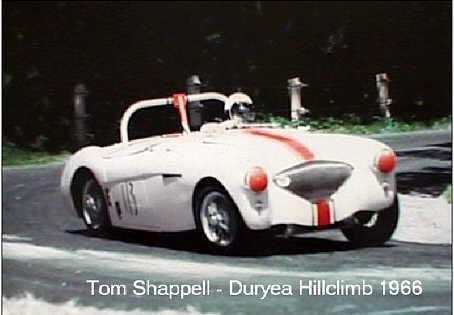
This car is #14 of the 19 hand-built, aluminum bodied Pre-Production cars. It was made at Donald Healeyís factory in Warwick prior to the first production of the Austin Healey 100 at the Austin plant in Longbridge, England.
Chassis BN1L 134373
Engine No. 1B136869
Body No. JM4134-14
When Donald Healey first showed his new prototype sports car at the London Car Show in October 1952, it was called the Healey 100. It was powered by an engine from the Austin A90, and had various other shared chassis components.
Leonard Lord of Austin recognized
an opportunity since Donald had more orders than he could fill in years
at his relatively small Healey plant in Warwick. Two days later, it became
the Austin Healey 100.

This car is #14 of the 19 hand-built,
aluminum bodied Pre-Production cars. It was made at Donald Healeyís factory
in Warwick prior to the first production of the Austin Healey 100 at the
Austin plant in Longbridge, England.
It has been carefully restored to retain most of its unique fabrication aspects which differed from production cars. All body panels, engine and frame are original.
At the same time it carries the
modifications that were done in the 1960ís that gave the car a second career
in its existence as a hill climb race car in southern Pennsylvania.
This car was modified for Hillclimb
racing, but one of its best advantages was its lightweight.
Weight: Total - 2001 lbs (including
full fuel tank = 120 lbs of gasoline) Front - 52% Rear - 48%
By contrast, a 100S had a curb
weight of 2,115 lbs (R&T Sept í55)
Engine: (Original Block)
Both Block & Head Planed
Flywheel Lightened
AH LeMans Camshaft
Head Ported, Polished, CCíd
Derrington Headers into a Burgess
Muffler
Mallory Dual Point Distributor
Mallory Magna-Spark Coil
Engine Balanced
Suspension:
Heavy Duty Anti-Roll Bar
Stiffened Rear Springs, 8 Leaves
Modified Shocks
Brakes:
Front Ė Girling BN7, Disc Brakes
Rear - Girling BN1, with Alfin
Drums
Tires;
5.50 x 15 Dunlop Racing
Warwick-Built Special Cars


NOTES:
#5 was NOJ 391
#6 was NOJ 392
#7 was NOJ 393
#8 was "Not registered"
There were only 19 cars: #10 was
never built


Ray Stichler was a young mechanic who worked at Ladd Motors in Lebanon PA. AHX-14 had been traded in at Ladd Motors in the summer of 1961 and was there for about 2 months just sitting out back. The engine was not too good and had little compression. Itís general condition was good, but worn. Jim Ladd was an avid racer who persuaded him to build this car for hillclimb racing. He bought the car in the fall, and it took a almost a year to build, but he got a lot of help from Ken Kershner, Jim Laddís race car mechanic, to help prepare the car properly. A lot of the engine and chassis work was done at Ladd Motors.
James (Toby) Tobias was
their "Service Advisor" and he made other changes such as conversion to
disc brakes, and improved suspension. Ray recalls spending what seemed
to be endless hours on the head. He ported and polished until it shined
like chrome. The flywheel was cut down and balanced. The final compression
of the rebuilt engine was so severe that they had to always tow start the
car for the first year. With the car painted dark blue, Ray raced it actively
in the Pennsylvania Hillclimb Association as car #10 & #101.

Ray has won boxes of trophies with
the car, and never finished worse than 3rd in any race he entered, but
mostly firsts.

Ray raced the car for 2 seasons
and later traded the car in for a new MG. The MGB offered him seating enough
for his family and the ability to continue racing on weekends. At the dealership
James Ladd Jr. and his brother Robert became the new owners.

Jim and Robert Laddís father owned Ladd-Hanford Motors Inc. in Lebanon Pa. Jim & Bob shared their interest and ownership in this car.




This car was as much of a show car as a race car as he points out with his photograph of it on review at the Reading Hospital Annual Tea Party and Car Show in the fall of 1966 when it was painted white with red/orange and blue racing stripe trim.



